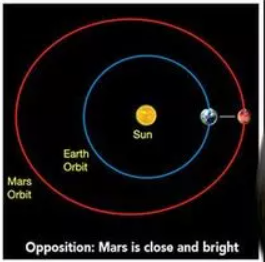Geography
Mars Opposition
- 14 Oct 2020
- 3 min read
Why in News
Due to the ‘opposition’ effect, Mars will look much brighter and bigger than usual in October 2020.
Key Points
- About Opposition:
- Opposition, in astronomy, is the circumstance in which two celestial bodies appear in opposite directions in the sky.
- Examples:
- The Moon, when full, is said to be in opposition to the Sun; the Earth is then approximately between them.
- A superior planet (one with an orbit farther from the Sun than Earth’s) is in opposition when Earth passes between it and the Sun.
- The opposition of a planet is a good time to observe it, because the planet is then typically at its nearest point to the Earth for a given year and because it is close, the planet appears brighter in the sky.
- The planets Venus and Mercury, whose orbits are smaller than Earth’s, can never be in opposition to the Sun.
- About Mars Opposition: Mars and the Sun are on directly opposite sides of Earth.
- Timing:
- About every 26 months, the Earth passes between the Sun and Mars, this is when the three are arranged in a straight line.
- In 2020, while Mars’ closest approach to Earth was on 6th October, the opposition happened on 13th October.
- Mars’s next close approach will happen on 8th December, 2022, when the planet will be 62.07 km away from the Earth.
- Significantly, the closest distance is relative and hence can vary.
- As per NASA, Mars made its closest approach to Earth in 2003 in nearly 60,000 years and it won’t be that close to the planet until 2287.
- This is because the orbits of Earth and Mars are not perfectly circular and their shapes can change slightly because of gravitational tugging (pulling) by other planets. For instance, Jupiter influences the orbit of Mars.
- Timing:
- Significance:
- Mars will outshine Jupiter, becoming the third brightest object (moon and Venus are first and second, respectively) in the night sky during the month of October.
- During Opposition, Mars appears as a bright star to the unaided eye and when viewed from a telescope, it grows dramatically in size. Using a telescope shows more of the planet’s details such as dark and light regions, the solar ice caps and Mars’ surface.







